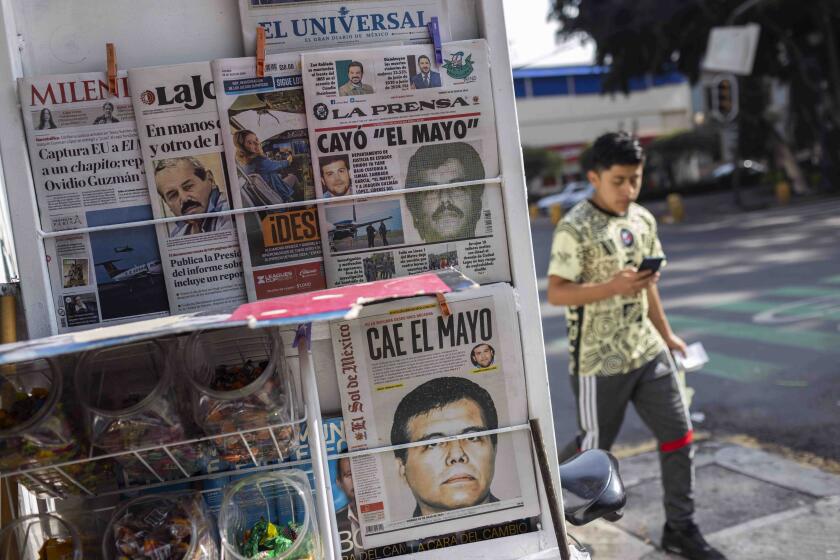Anthrax subject receives payout
The former Army scientist who was the prime suspect in the deadly 2001 anthrax mailings agreed Friday to take $5.82 million from the government to settle his claim that the Justice Department and the FBI invaded his privacy and ruined his career.
Dr. Steven J. Hatfill, 54, who was called a “person of interest” in the case by then-Atty. Gen. John Ashcroft in 2002, said that label and repeated leaks of investigative details to the media damaged his reputation.
For months in the anxious atmosphere after Sept. 11, Hatfill was subjected to 24-hour surveillance and was widely identified as the leading suspect in the nation’s first bioterrorism attack. However, he was never arrested or charged and a federal judge presiding over his lawsuit said recently that there “is not a scintilla of evidence” linking him to the mailings.
Former federal prosecutors knowledgeable about the investigation said the government payout to Hatfill signified that, in all likelihood, he would never be charged.
A spokesman for the Justice Department said the anthrax case “remains among the department’s highest law enforcement priorities.” Brian Roehrkasse also said in a statement that by agreeing to settle the lawsuit, the government “does not admit to any violation of the Privacy Act and continues to deny all liability in connection with Dr. Hatfill’s claims.”
The settlement calls for an immediate $2.82-million payment to Hatfill. Beginning in 2009, the government will pay Hatfill an annuity of $150,000 a year for 20 years, according to court papers.
Hatfill’s lawyer, Thomas C. Connolly, said that his client would have no comment on the settlement. “We took this case to defend very fundamental principles of fairness,” Connolly said.
Another lawyer for Hatfill, Mark A. Grannis, said Friday: “If anybody in the country really knew what it was like to be Steven Hatfill for the past six years, nobody would trade places with him.” Grannis faulted “a handful of credulous reporters,” who he said published or broadcast government leaks of “gossip, speculation and misinformation.”
The lawsuit was filed in August 2003, but U.S. District Court Judge Reggie B. Walton delayed permitting Hatfill’s lawyers to question FBI and Justice officials or news reporters for two more years. The government contended that the depositions of agents and FBI leaders could interfere with the investigation.
Connolly and Grannis oversaw depositions that eventually elicited sworn testimony from 37 witnesses, including Ashcroft and FBI Director Robert S. Mueller III.
Hatfill’s lawyers told Walton at a January hearing that they had identified three officials who allegedly leaked confidential information. The officials -- former U.S. attorney for Washington, Roscoe C. Howard Jr.; his former criminal division chief, Daniel S. Seikaly; and a former FBI spokesman, Edwin Cogswell -- have not spoken publicly on the allegation.
At that hearing, Walton ordered attorneys for the government and for Hatfill to try to settle the case. On Feb. 19, he signaled that he saw the government’s pursuit of Hatfill as questionable. The judge had reviewed four still-secret FBI memos about the status of the anthrax investigation.
“There is not a scintilla of evidence that would indicate that Dr. Hatfill had anything to do with this,” Walton said.
Hatfill was trained in Zimbabwe as a physician and practiced medicine in South Africa. He later worked at Ft. Detrick, Md., researching how to counter the effects of deadly biological agents. No physical evidence or witnesses ever linked him to anthrax and he long insisted that he had nothing to do with the mailings.
Those mailings -- hand-addressed letters bearing tiny amounts of deadly anthrax powder -- set off new waves of terror in the weeks after the Sept. 11 attacks. The first letter arrived at American Media Inc. in South Florida. About Sept. 18, photo editor Robert Stevens, 63, breathed in spores of the bacterium while examining a letter. He died Oct. 5. Other letters laced with the same strain of anthrax were addressed to others in the media, including two network anchors. Two letters were addressed to U.S. senators. Of the five anthrax-related deaths, two were U.S. Postal Service workers in the Washington area.
Hatfill’s plight recalls the targeting of Richard Jewell, a guard at the 1996 Atlanta Olympics who alerted police to a suspicious backpack and moved bystanders away. The backpack exploded, killing a woman and injuring more than 100. Jewell was praised; then media accounts described him as “the focus” of the FBI investigation. Another man later confessed. Then-Atty. Gen. Janet Reno apologized to Jewell, who died last year.
Rep. Rush D. Holt (D-N.J.), whose district includes Princeton, where anthrax spores were recovered from a mailbox, said the government’s payout to Hatfill confirmed that the investigation “was botched from the very beginning.”
“The FBI did a poor job of collecting evidence, and then inappropriately focused on one individual as a suspect for too long, developing an erroneous ‘theory of the case’ that has led to this very expensive dead end,” Holt said in a statement.
--
--
Times researcher Janet Lundblad in Los Angeles contributed to this report.
More to Read
Sign up for Essential California
The most important California stories and recommendations in your inbox every morning.
You may occasionally receive promotional content from the Los Angeles Times.










